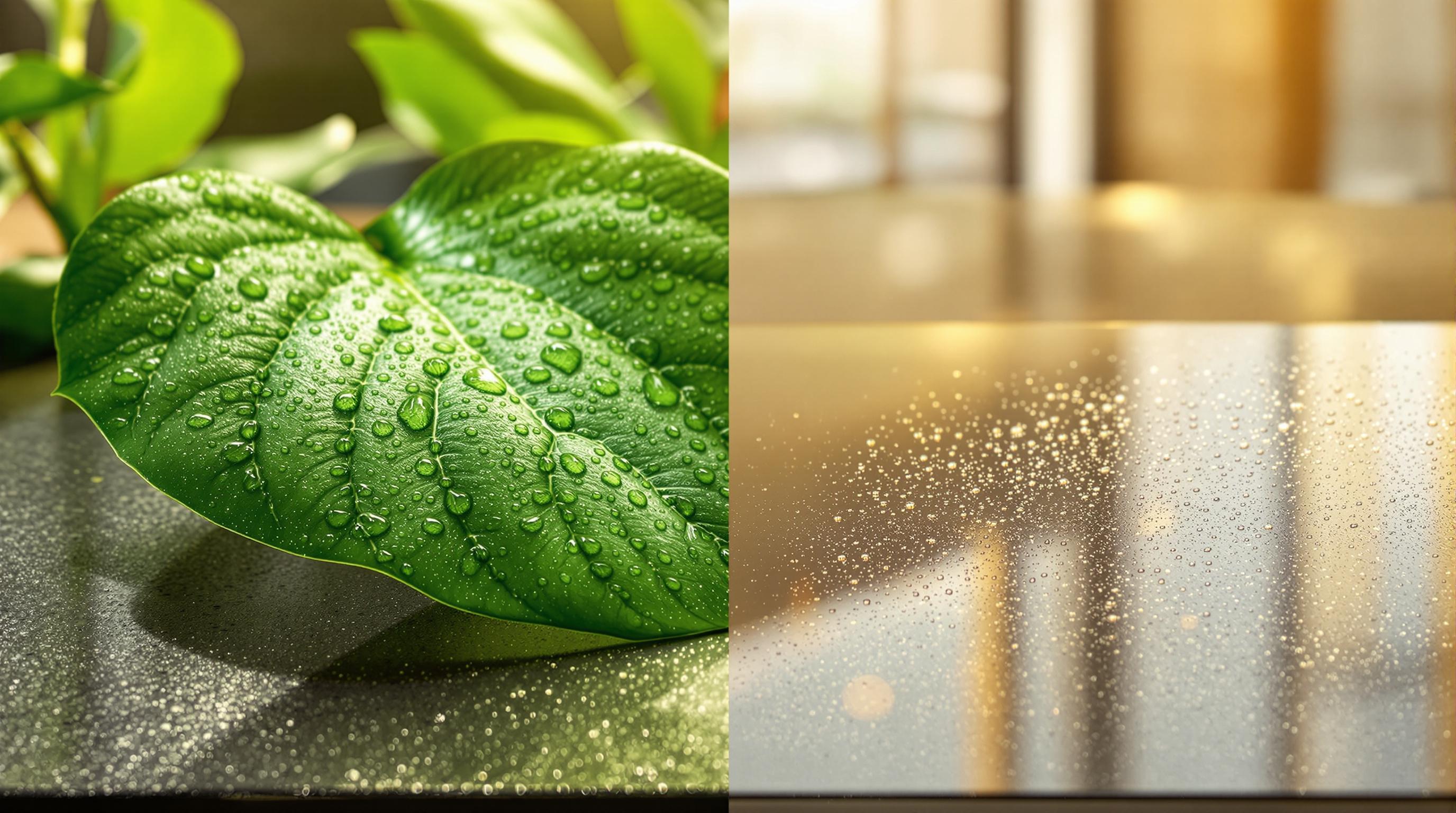UV-resistant nanocoatings are a game-changer for textiles, offering ultra-thin protection against harmful UV rays while keeping fabrics breathable and durable. These coatings prevent color fading, fiber damage, and material breakdown, making them ideal for outdoor and technical textiles. Plus, PFAS-free options ensure safer, eco-friendly solutions. Here's what you need to know:
-
Key Benefits:
- Blocks UV rays through absorption and light scattering.
- Extends fabric life by reducing wear and fading.
- Maintains texture, breathability, and comfort.
- PFAS-free options lower environmental impact.
-
Types of Coatings:
- Metal Oxide: Uses titanium dioxide (TiO₂) or zinc oxide (ZnO) for strong UV protection.
- Polymer-Based: Flexible, durable, and PFAS-free.
- Mixed Organic-Inorganic: Combines durability with eco-friendly formulations.
-
Applications:
- Outdoor gear, athletic wear, technical textiles, and upholstery.
UV-resistant nanocoatings are transforming the textile industry by combining performance with sustainability. For more details, visit PFAS-Free & Sustainable Water Repellents.
UV-Resistant Nanocoating Functions
How Nanocoatings Block UV Rays
UV-resistant nanocoatings create ultra-thin, uniform layers that protect against UV rays through two key methods:
| Protection Mechanism | Description |
|---|---|
| UV Absorption | Nanoparticles absorb UV energy, reducing fiber damage caused by exposure. |
| Light Scattering | The coating's structure disperses UV rays, minimizing their direct impact on the fabric. |
This nanoscale protection allows textiles to retain their natural feel and breathability while offering improved UV resistance.
Nanocoatings vs. Standard UV Treatments
Nanocoatings provide more advanced UV protection compared to traditional treatments, thanks to their ultra-thin layers that maintain fabric texture and performance.
| Feature | Nanocoatings | Standard Treatments |
|---|---|---|
| Layer Thickness | Ultra-thin (nanometers) | Thicker (micrometers) |
| Durability | Better wash resistance and long-lasting protection | Protection weakens with wear |
| Fabric Properties | Maintains original texture and breathability | Can change the fabric's natural feel |
| Environmental Impact | Often available in PFAS-free options | May include harmful chemicals |
| UV Protection Level | Consistent and durable | May decrease over time |
Some advanced sol-gel nanocoatings also provide water repellency, especially in PFAS-free formulations, making them ideal for outdoor and technical fabrics. Learn more at PFAS-Free & Sustainable Water Repellents.
Nanocoating and Technology: Advanced Surface Protection Solutions
Main UV-Resistant Nanocoating Types
Nanocoatings designed for UV resistance offer advanced protection for textiles, catering to specific performance requirements. These coatings use nanotechnology to shield fabrics from harmful UV rays while maintaining their original quality and functionality.
Metal Oxide Nanocoatings
Metal oxide nanocoatings use materials like titanium dioxide (TiO₂) and zinc oxide (ZnO) to protect textiles from UV radiation. TiO₂ offers broad-spectrum defense against both UVA and UVB rays, while ZnO is particularly effective against UVA rays. This makes these coatings ideal for applications like athletic wear, outdoor gear, children's clothing, and swimwear.
Polymer-Based Nanocoatings
Polymer-based nanocoatings go a step further by integrating UV-absorbing compounds into a flexible matrix. This design ensures the coating conforms to the fabric, providing UV protection along with water repellency. These formulations are also free of PFAS, making them a more environmentally friendly option. They are durable through multiple wash cycles and maintain the breathability of the fabric, making them suitable for a wide range of textiles. Companies like PFAS-Free & Sustainable Water Repellents are leading the way in these eco-conscious designs.
Mixed Organic-Inorganic Coatings
Mixed organic-inorganic coatings combine the strengths of both material types. These sol-gel hybrid systems offer long-lasting UV protection while preserving the comfort of the fabric. The coatings create a protective network that bonds with the fibers, improving resistance to washing and wear. Designed without PFAS, they align with current environmental standards. These coatings are especially useful for outdoor and technical textiles that need both UV and water protection, providing a balance of performance and eco-friendly attributes.
sbb-itb-3ba7a4c
Uses and Advantages of UV Nanocoatings
Extending Product Life and Strength
UV-resistant nanocoatings form an ultra-thin layer that helps fabrics last longer by preserving their structure, breathability, and appearance. They prevent color fading, fiber damage, and overall material breakdown.
PFAS-free nanocoatings are designed to maintain fabric durability even after multiple washes. This helps keep textiles in good condition and reduces the need for frequent replacements.
By combining UV protection with water repellency, these coatings add an extra layer of durability to textiles.
Applications in Clothing and Technical Textiles
The benefits of UV-resistant nanocoatings have led to their use in a wide range of textile applications. Their ability to improve durability and extend the life of fabrics makes them particularly useful for performance and technical textiles. In industries like outdoor gear, these coatings protect items exposed to harsh sunlight and moisture.
Here’s how they are applied across different sectors:
| Industry Sector | Applications | Key Benefits |
|---|---|---|
| Outdoor Gear | Hiking clothing, camping gear | Protection from UV rays and water |
| Athletic Wear | Sports uniforms, training gear | UV defense without losing breathability |
| Technical Textiles | Industrial covers, agri-textiles | Long-lasting protection from elements |
| Upholstery | Outdoor furniture fabrics | Maintains color and material strength |
The textile and apparel industry is increasingly adopting PFAS-free nanocoatings as a more sustainable solution for UV and water protection. These coatings provide reliable performance without affecting the fabric's natural properties, making them especially useful for outdoor and high-performance applications.
For more details on PFAS-free, sustainable water-repellent solutions, visit PFAS-Free & Sustainable Water Repellents.
Safety and Environmental Impact
Beyond performance features, it's crucial to consider safety and environmental factors.
Nanoparticle Safety in Textiles
Thorough testing shows that nanoparticles stay securely embedded in textiles, minimizing the risk of release during wear or washing. This emphasis on safety aligns with the push for more eco-conscious nanocoating technologies.
Non-Toxic UV Protection Options
Concerns about the environment are driving the move toward safer UV protection methods. PFAS-free coatings now deliver reliable UV protection without harmful chemicals. Leveraging advanced nanotechnology, these coatings also provide water resistance and long-lasting durability.
The creation of UV-resistant nanocoatings that prioritize the environment is a major step forward in textile protection. These solutions balance ecological considerations with industry standards. To explore PFAS-free options further, manufacturers can visit the PFAS-Free & Sustainable Water Repellents website at https://sustainabledwr.com.
Next Steps in UV Nanocoating Tech
Building on earlier advancements in durability and eco-conscious solutions, the textile industry is now shifting its focus to multi-functional coatings. These coatings aim to provide a mix of protective features while keeping environmental concerns in mind.
Multi-Function Coating Systems
Researchers are working on coatings that do more than just protect against UV rays. These advanced solutions combine UV protection with water and stain resistance, along with improved durability. The result? Treatments that are both efficient and versatile.
Using nanotechnology, these coatings form ultra-thin layers that deliver a range of benefits, including UV resistance, water repellency, and stain protection, all while boosting durability.
One promising approach is the use of sol-gel systems. These systems not only offer long-lasting protection but also align with sustainability goals. With stricter regulations on the horizon, manufacturers are exploring options like nanotechnology-driven hydrophobic coatings and biodegradable water repellents.
Conclusion
UV-resistant nanocoatings offer a new level of textile protection by creating ultra-thin layers that shield fabrics from harmful UV rays while keeping their original texture intact. These coatings also serve a dual purpose by blocking UV rays and repelling water and dirt, making them a practical choice for outdoor and technical textiles.
Another important factor is their environmental impact. Modern PFAS-free, sol-gel-based formulations match the performance of traditional treatments while being more eco-friendly. For more details, check out PFAS-Free & Sustainable Water Repellents.
Thanks to nanotechnology, fabrics remain breathable and comfortable while gaining strong UV resistance. Looking ahead, future coatings may combine UV protection with other features, opening the door to efficient and environmentally friendly textile innovations.


